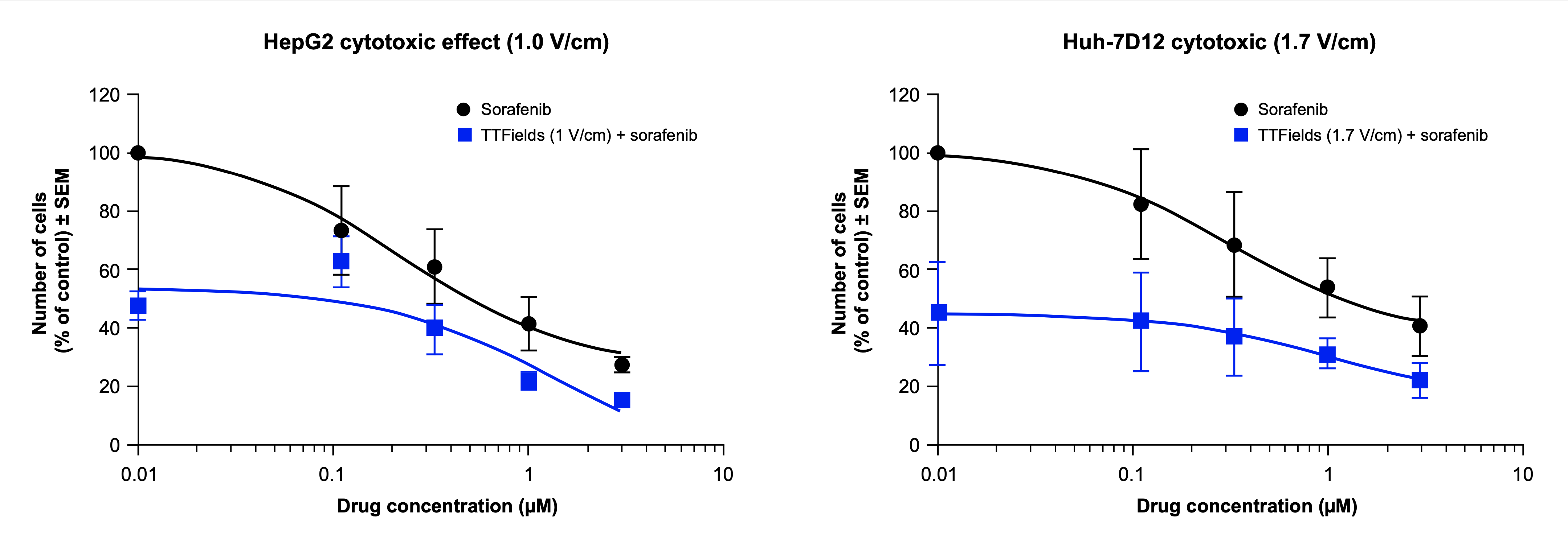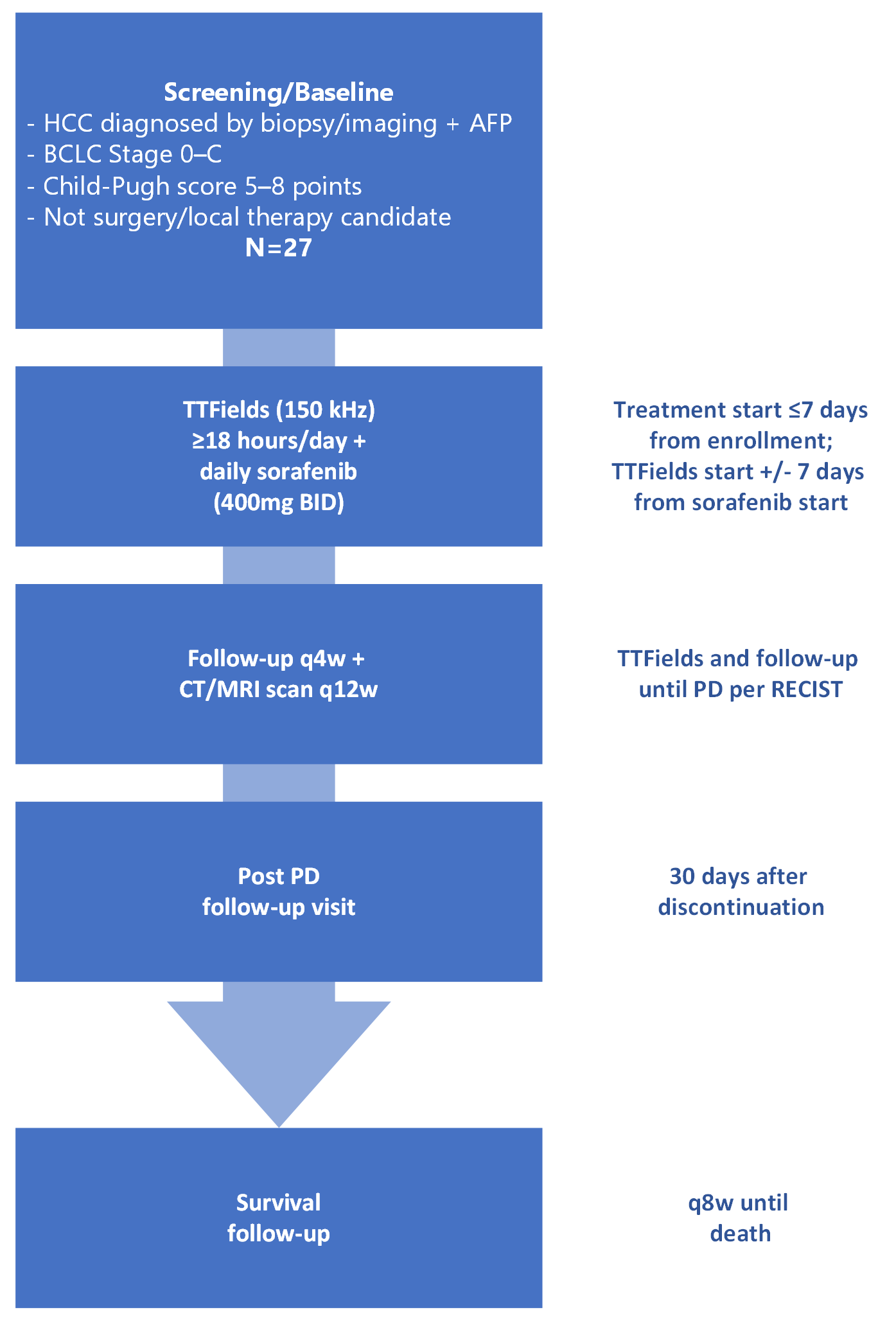Hepatocellular carcinoma (HCC) accounts for >80% of primary liver cancers worldwide.1 Despite advances in medical, locoregional and surgical therapies, HCC remains a major contributor of cancer-related sufferings and deaths in many regions in the world, particularly in Asia.2 Currently, first-line treatment recommendations for patients with advanced or metastatic disease, or for those progressing on locoregional therapies, is systemic therapy with sorafenib, lenvatinib, or atezolizumab plus bevacizumab.3
The therapeutic advantage of TTFields in HCC was initially demonstrated through in vitro and in vivo studies, which showed optimal antiproliferative effects at a frequency of 150 kHz.4,5 The studies also suggested that the combination of TTFields with sorafenib enhanced treatment efficacy for HCC compared with each treatment alone (Figure) due to increased cytotoxic effects and reduction in tumor volume.4,5
Figure. TTFields augmented effects of sorafenib* in HCC cell lines4

*p<0.001 for cytotoxicity effects for sorafenib alone vs sorafenib + TTFields; 2-way ANOVA. SEM, standard error of mean; TTFields, Tumour Treating Fields.
Adapted from Potter W, et al. 20224
The phase II HEPANOVA clinical trial subsequently investigated the efficacy and safety of TTFields concomitant with sorafenib in patients with advanced HCC.6 Final analysis of the study reported promising efficacy with no unexpected safety signals, despite the very poor prognosis of the study population and very low exposure to study treatments compared to previous studies.6
Based on these positive findings, in September 2021, the US Food and Drug Administration granted breakthrough device designation to TTFields intended for use together with atezolizumab plus bevacizumab for the first-line treatment of patients with unresectable or metastatic liver cancer.7
References:
- Sung H, et al. CA Cancer J Clin 2021;71:209-249.
- Yang JD, et al. Nat Rev Gastroenterol Hepatol 2019;16:589-604.
- NCCN. NCCN Clinical Practice Guidelines in Oncology (NCCN Guidelines®) Hepatobiliary Cancers. Version 5.2021–September 21, 2021. Available at: https://www.nccn.org/professionals/physician_gls/pdf/hepatobiliary.pdf. Accessed 2 March 2022.
- Potter W, et al. Tumor treating fields (TTFields) in combination with sorafenib inhibit hepatocellular carcinoma in vitro and in vivo. Presented at ASCO Gastrointestinal Cancers Symposium; 20–22 January 2022; San Francisco, CA, USA. Poster 464.
- Davidi S, et al. Safety and effectiveness of tumor treating fields combined with sorafenib in preclinical models of hepatocellular carcinoma. Presented at the Virtual ESMO World Congress on Gastrointestinal Cancer; 1–4 July 2020. Poster 261.
- Gkika E, et al. Cancers (Basel) 2022;14:1568.
- Novocure. FDA grants breakthrough device designation to the NovoTTF-200T™ System for advanced liver cancer September 9, 2021. Available at: https://www.novocure.com/fda-grants-breakthrough-device-designation-to-the-novottf-200t-system-for-advanced-liver-cancer. Accessed 2 March 2022.
HEPANOVA in HCC
The HEPANOVA (EF-30) study was a prospective phase II, single arm, historical control study investigating the efficacy and safety of TTFields concomitant with sorafenib for the treatment of patients with advanced hepatocellular carcinoma (HCC).1
Study design1

AFP, alpha-fetoprotein; BCLC, Barcelona Clinic Liver Cancer; BID, twice daily; CT, computed tomography; HCC, hepatocellular carcinoma; ECOG, Eastern Cooperative Oncology Group; MRI, magnetic resonance imaging; ORR, overall response rate; PD, progressive disease; q4w, every 4 weeks; q8w, every 8 weeks; q12w, every 12 weeks; RECIST, response evaluation criteria in solid tumors; TTFields, Tumour Treating Fields.
Adapted from Gkika E, et al. 20221
The study recruited 27 patients with advanced, unresectable HCC who were amenable to systemic therapy with sorafenib following failure of loco-regional treatment options.1 Implanted electronic devices in the torso was exclusionary. Patients received TTFields at a frequency of 150 kHz using the NovoTTF 100L(P) System for at least 18 hours concomitant with standard sorafenib treatment at 400 mg twice a day.1
- Primary endpoint: Overall response rate (ORR)
- Secondary endpoints: In-field control rate; progression-free survival rate at 12 months; 1-year overall survival (OS) rate; 1-year distant metastases-free survival rate; safety
Baseline characteristics
Compared to previous studies, patients enrolled in HEPANOVA had very poor disease prognosis: 14 of the 27 patients (52%) had a Child-Pugh score of 7 or 8, and 22% had an Eastern Cooperative Oncology Group (ECOG) score of 2.1 Six patients (22%) survived less than 12 weeks.1 The median sorafenib treatment was 9 weeks versus a median of 16–21 weeks in historical controls.1 The median TTFields treatment duration was 10 weeks.1
The baseline characteristics of the study population are summarized below (Table 1):
Table 1. Baseline and disease characteristics of patients treated with TTFields concomitant with sorafenib1
| Characteristics | TTFields + sorafenib (N=27) |
|---|---|
| Median age, years (range) | 65 (28–85) |
| Male, no. (%) | 26 (96.3) |
| ECOG performance status, no. (%) | |
| 0 | 12 (44.4) |
| 1 | 9 (33.3) |
| 2 | 6 (22.2) |
| Child-Pugh score, no. (%) | |
| 5 | 9 (33.3) |
| 6 | 4 (14.8) |
| 7 | 10 (37.0) |
| 8 | 4 (14.8) |
| BCLC Stage, no. (%) | |
| 0 | 1 (3.7) |
| B | 5 (18.5) |
| C | 21 (77.8) |
| Median time from diagnosis to enrollment, weeks (range) | 25.6 (1.9–345.9) |
BCLC, Barcelona Clinic Liver Cancer; ECOG, Eastern Cooperative Oncology Group; TTFields, Tumour Treating Fields.
Response efficacy results
In the evaluable patients (N=21), TTFields concomitant with sorafenib resulted in an ORR of 9.5% (Table 2), numerically higher than the reported for sorafenib alone from previous studies by approximately twofold but not significantly different (ORR 4.5%; p=0.24).1 In patients who completed at least 12 weeks of TTFields treatment (N=11), the ORR was 18% and the disease control rate was 91%.1
Table 2. Responses in all evaluable patients treated with TTFields concomitant with sorafenib1
| Outcome | TTFields ≥12 weeks + sorafenib (N=11) | TTFields + sorafenib (N=21) |
|---|---|---|
| Overall response rate, % | 18 | 9.5 |
| Level of response, % | ||
| Complete | 0 | 0 |
| Partial | 18 | 9.5 |
| Stable disease | 73 | 66.5 |
| Disease control rate, % | 91 | 76 |
Investigator assessed response per RECIST criteria. Not all endpoint presented were prespecified.
RECIST, response evaluation criteria in solid tumors; TTFields, Tumour Treating Fields.
Secondary endpoint results in the intent-to-treat population are shown below (Table 3)1:
Table 3. Secondary efficacy endpoints in patients treated with TTFields concomitant with sorafenib1
| Outcome | TTFields + sorafenib (N=27) |
|---|---|
| In-field control rate at 1 year, % | 9.5% |
| Median PFS, months (95% CI) | 5.8 (3.0–8.9) |
| Median time to progression, months (95% CI) | 8.9 (3.1–not reached) |
| PFS12, % (95% CI) | 23 (7–45) |
| 1 year survival rate, % (95% CI) | 30 (11–52) |
| Distant metastases-free survival rate at 1 year, % (95% CI) | 26 (8–49) |
Investigator assessed response per RECIST criteria. Not all endpoint presented were prespecified.
CI, confidence interval; PFS, progression-free survival; PFS12, PFS at 12 months; RECIST, response evaluation criteria in solid tumors; TTFields, Tumour Treating Fields.
Safety
In the HEPANOVA study, treatment with TTFields concomitant with sorafenib was not associated with any new toxicity signals.1 In total, 26 patients (96%) experienced ≥1 adverse event; the most frequent adverse events were diarrhea (56%), asthenia (41%), decreased appetite (30%) and ascites (22%) (Table 4).1
Table 4. All AEs occurring in >10% of patients treated with TTFields concomitant with sorafenib1
| Preferred Terms, n (%) | TTFields + Sorafenib (n = 27) |
|---|---|
| Patients with any ≥1 AE | 26 (96) |
| Diarrhea | 15 (56) |
| Asthenia | 11 (41) |
| Decreased appetite | 8 (30) |
| Ascites | 6 (22) |
| Dermatitis | 5 (19) |
| Dyspnea | 5 (19) |
| Edema peripheral | 5 (19) |
| Alanine aminotransferase increased | 4 (15) |
| Palmar-plantar erythrodysesthesia syndrome | 4 (15) |
| Skin erosion | 4 (15) |
| Anemia | 3 (11) |
| Aspartate aminotransferase increased | 3 (11) |
| Constipation | 3 (11) |
| Dry mouth | 3 (11) |
| Hypertension | 3 (11) |
| Nausea | 3 (11) |
| Transaminases increased | 3 (11) |
Numbers and percentages have been rounded to the nearest integer.
AE, adverse event; TTFields, Tumour Treating Fields.
Nine patients (33%) reported ≥1 mild to moderate (grade 1–2) adverse events while 16 patients (59%) had severe (grade 3–4) adverse events. Serious adverse events were experienced by 13 patients (48%), none of which were related to TTFields.1 A list of grade 3–4 adverse event by system organ class that were seen in ≥5% in the study population is summarized as follows (Table 5):
Table 5. Severe (grade 3–4) AEs occurring in >5% of patients treated with TTFields concomitant with sorafenib1
| MedDRA Version 21.0 Preferred Term, n (%) | TTFields + Sorafenib (n = 27) |
|---|---|
| Severe (Grade 3–4) |
|
| Patients with any ≥1 AE | 16 (59) |
| Decreased appetite | 3 (11) |
| Ascites | 2 (7) |
| Diarrhea | 2 (7) |
| Asthenia | 2 (7) |
| Edema peripheral | 2 (7) |
| Pathological fracture | 2 (7) |
| Dyspnea | 2 (7) |
| Palmar-plantar erythrodysesthesia syndrome | 2 (7) |
| Hypertension | 2 (7) |
Percentage values have been rounded to the nearest integer.
AE, adverse event; MedDRA, Medical Dictionary for Regulatory Activities; TTFields, Tumour Treating Fields.
Of the 26 patients with ≥1 adverse event, 7 (26%) experienced events that were deemed not related to TTFields therapy. Nineteen patients (70%) had TTFields-related skin toxicity: 18 patients (67%) were observed to have mild to moderate (grade 1–2) events, and only one patient (3%) had a severe (grade 3) event of skin erosion.1 The most common grade 1–2 treatment-related skin adverse event was dermatitis (19%).
Summary
Despite the very poor prognosis of the study population and very low exposure to study treatments compared to previous studies, the HEPANOVA trial demonstrated promising efficacy results with TTFields concomitant with sorafenib in patients with advanced HCC. There were no unexpected safety signals. These findings warrant the investigation of TTFields for the treatment of HCC in a randomized controlled trial.
Reference:
- Gkika E, et al. Cancers (Basel) 2022;14:1568.